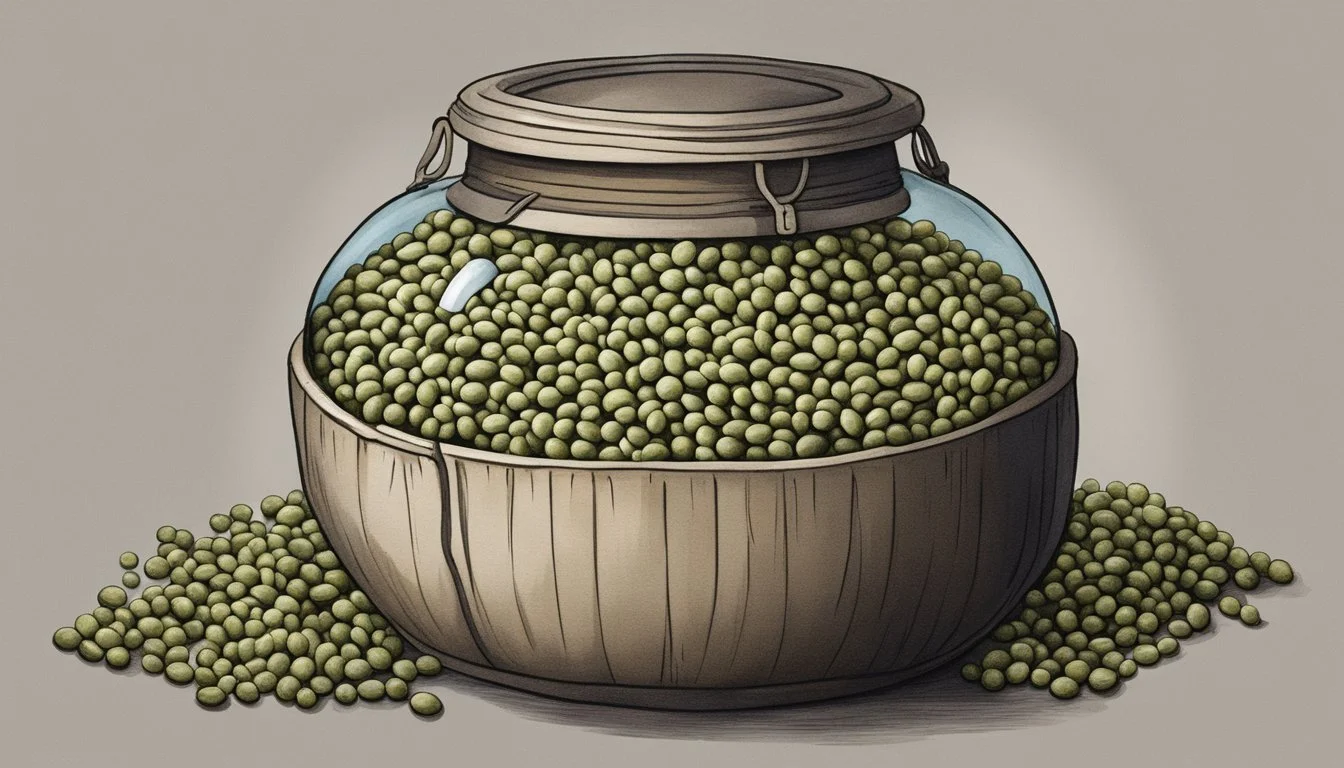How to Ferment Kanjang
Mastering Traditional Korean Soy Sauce Brewing
Kanjang, the traditional Korean soy sauce, is a staple in Korean cuisine, revered for its rich, savory depth of flavor. This fermented condiment is created through a process that honors the age-old methods handed down through generations. Fermentation is central to its production and distinguishes Kanjang from its less complex counterparts. It involves a careful blend of soybeans, brine, and time, allowing natural enzymes to work their transformative magic.
The creation of Kanjang is both an art and a science, starting with selecting quality soybeans that are then boiled and mashed. This paste serves as the base for fermentation, combined with brine and other ingredients such as wheat, resulting in Meju blocks. The blocks are then left to ferment, a delicate stage where temperature and environmental conditions play a critical role. After an extensive period, the blocks are submerged in saltwater, initiating the prolonged maturation that develops Kanjang's characteristic flavor.
This process, although it requires patience and precision, results in a soy sauce that imbues dishes with an authentic flavor profile that is unmistakably Korean. Kanjang not only adds depth to the dishes it accompanies but also connects those who partake with a rich culinary heritage. Whether used in marinades, dipping sauces, or soups, this traditionally fermented soy sauce is an essential Korean condiment that elevates the dining experience.
Historical Significance
The origins and development of Kanjang are deeply rooted in Korean traditions and the culinary evolution, fostering a rich heritage within Korean food (What wine goes well with Korean food?) culture. These aspects are crucial for understanding its value and role in Asian gastronomy.
Korean Food Culture
Historically, fermented soy products like Kanjang have been a cornerstone in Korean cuisine. They are indicative of Korea's mastery in fermentation techniques, a skill that Koreans have honed over thousands of years. Ganjang (Korean soy sauce) has not only served as a seasoning but also played an integral role in the preservation of food. It embodies a shared cultural legacy across generations, signifying the communal aspect of Korean dining where it routinely accompanies a variety of dishes.
Evolution of Soy Fermentation
The fermentation process of Kanjang can trace its roots back to ancient Korea, paralleling that of China and Japan, yet featuring unique Korean innovations. Initially, fermented soybean paste acted as a food preservative and flavor enhancer. Over time, practitioners refined and adapted these methods, ultimately giving rise to the distinct Korean soy sauce. Each evolution marked a step towards the ganjang known today, a process that involves meticulously cultivating and aging the soy fermentation blocks, known as meju. This illustrates the dynamic nature of food preservation and flavoring practices within Korean culture, an evolution that is both an art and a science.
Essential Ingredients
The quality of soy sauce hinges on its essential ingredients. A harmonious blend of soybeans, salt, water, and additional flavorings lay the foundation for an authentic Kanjang.
Soybeans and Their Impact
Soybeans are the cornerstone of Kanjang, supplying both the protein and the unique flavor profile. One typically soaks soybeans in water, allowing them to swell to the right consistency before mashing them into a paste that undergoes fermentation.
Salinity's Role
Salt is critical not only to taste but also as a preservation agent. It controls unwanted microbial growth during fermentation. Water is mixed with salt to create a brine, which is fundamental to the soybean fermentation process. The ratio of soybeans, salt, and water must be precise:
Soybeans: 1 part
Salt: 0.15 to 0.20 parts
Water: 3 to 4 parts
Additional Flavorings
Additional flavorings such as onion, garlic, apple, ginger, and kelp can be incorporated to enrich the complexity of the soy sauce. These ingredients are not mandatory but can tailor the taste to individual preferences. They are added to the fermentation mixture in varying amounts to achieve the desired flavor profile. For example:
Onion/Garlic: 0.01 part (optional for added depth)
Apple/Ginger: 0.01 part (optional for a hint of sweetness and warmth)
Kelp: 0.01 part (optional for umami enhancement)
Preparation Techniques
The preparation of Kanjang involves meticulous steps to ensure the rich flavor and proper fermentation. Each stage, from processing the raw ingredients to setting the initial fermentation environment, is critical in crafting this traditional Korean soy sauce.
Soybean Processing
One begins with dried soybeans, soaking them in water to hydrate and expand. Typically, a ratio of 1:4 (soybeans to water) is maintained, and they should soak for at least 12 to 24 hours. After soaking, one places the beans in a colander or strainer and removes any broken beans. Then, the clean soybeans are boiled until tender and mashed into a paste using a wooden spoon. This paste is shaped into blocks called meju, which are then dried for a period, varying from weeks to months, until fully fermented.
Combining Ingredients
After fermentation, the meju blocks are crumbled into small pieces and placed in a large pot along with water and kosher salt, achieving a mixture with around 20% salt content. Additional ingredients for flavor, such as rice, could be added. To enhance the fermentation process, other components like chili pepper, garlic, and onion can be included, depending on the specific recipe or regional preference.
Initial Fermentation Setting
Post combining the meju and other ingredients, the mixture is transferred to a clay pot or a similar fermenting vessel. The surface of the mixture is covered with a cheesecloth or cotton cloth to prevent contaminants, while still allowing air to circulate. This pot is placed in an area with steady temperature and minimal direct sunlight, initiating the fermentation process. The concoction should be stirred regularly with a clean wooden spoon for even fermentation and to prevent mold growth. Following this initial setup, the Kanjang will go through a fermentation period that can last several months, during which it will develop its distinct flavor and aroma.
Fermentation Process
The fermentation of Kanjang is a delicate process that requires understanding the crucial stages and maintaining the right conditions to achieve the desired flavor and quality.
Understanding Fermentation Stages
Stage 1: Koji Cultivation One begins the fermentation of Kanjang with koji, which is a culture of Bacillus subtilis. This microorganism is cultivated on cooked grains (often rice or wheat) to create a moldy mixture that acts as the starter for fermenting soybeans.
Stage 2: Soybean Fermentation Soybeans are then cooked and mixed with the koji. The mixture is traditionally shaped into bricks, called meju, and wrapped with dried rice straw or hay which contains the natural bacteria needed to ferment the soy. These blocks are then placed in a bamboo basket or hung in an airy place to dry and ferment over weeks or months. This slow fermentation is critical in developing Kanjang's complex flavors.
Stage 3: Brine Fermentation The meju blocks are submerged in brine (saltwater) within an earthenware crock. The earthenware is known for its porosity, which is beneficial for the exchange of gases during fermentation. The crock is then covered with waxed paper to prevent contamination while still allowing breathability.
Stage 4: Maturation Over several months to years, the Kanjang matures, and its flavors deepen. Fermentation can be influenced by the environment, with factors such as room temperature playing a critical role. Some may employ an electric mat or the traditional Korean ondol (underfloor heating) to maintain a consistent temperature.
Maintaining Proper Conditions
Temperature Control: For optimal fermentation, room temperature should be kept steady, typically around 60-68°F (15-20°C). Fermenters may use modern appliances like an electric mat or traditional methods like ondol to sustain this temperature.
Environmental Factors: Many artisanal producers prefer natural environments where meju blocks are left to ferment near orchards or herb gardens to absorb those natural aromas. A controlled fermentation might be done inside a cardboard box or similar container, which can be insulated with dried straw to mimic traditional methods.
Moisture Levels: The moisture within the earthenware crock should be checked regularly. Too much moisture can lead to undesirable mold growth, while too little can halt the fermentation process. Fermenters must ensure the crock is properly sealed yet breathable, often using waxed paper as a covering.
By meticulously controlling these factors, one facilitates proper Kanjang fermentation, leading to a richly flavored and aromatic soy sauce that is a cornerstone of Korean cuisine.
Finishing and Maturing
The final stages of making Kanjang, commonly known as Korean soy sauce, are crucial for achieving the right balance of flavors and aromas. The process involves a careful balance of salt and caramel notes and requires patience to allow fermentation and maturation to develop the sauce's characteristic taste.
Final Fermentation
During the final fermentation phase, the soy sauce mixture is left in a warm place to ferment. This can take several months, and it's critical for the development of the sauce's complex flavor profiles. It's here that the salty water, known as brine, works in conjunction with the natural enzymes from the fermentation process to break down proteins and create a sauce that is rich in umami flavors. These enzymes gradually enhance the taste, melding the saltiness with a subtle caramel aroma that emerges from the fermented soybeans.
Aging for Flavor Development
Once the final fermentation is complete, the soy sauce enters the aging phase. This period is essential for allowing the flavors to mature and blend. Depending on the desired outcome, aging can last from months to years. The longer Kanjang ages, the more pronounced and refined its flavor becomes. During this time:
The sauce's salt content plays a critical role in preservation, preventing spoilage while the sauce develops its distinct taste.
Careful attention to temperature and storage conditions ensures a consistent aging process, fostering the fermentation activity that contributes to the sauce's caramel aroma and complexity.
Throughout this section of the soy sauce's production, the craftsmen must consistently monitor and adjust the conditions to ensure optimal development of taste and quality.
Serving and Usage
When incorporating Ganjang, or Korean soy sauce, understanding its flavor profile and application in cooking is essential. It imparts a savory umami quality to recipes and can be used with precision as a condiment.
Incorporating into Recipes
In cooking, Ganjang is often utilized in marinades for meat, bringing a deep, rich flavor that complements the natural taste of the protein. For a well-balanced marinade, chefs combine Ganjang with ingredients like garlic, sesame oil, and sugar to enhance the overall savoriness and tenderize the meat. In addition to marinades, Ganjang serves as a core element in various Korean recipes, acting as a seasoning that imparts a non-spicy, umami-rich depth to dishes. It is particularly prominent in banchan, which are Korean side dishes, where its salty character allows vegetables to shine. It's essential in making traditional soups and stews, where it's referred to as Korean soup soy sauce, contributing a milder and somewhat sweeter taste compared to regular soy sauce.
Serving as a Condiment
As a condiment, Ganjang is frequently provided at the table as an accompaniment to meals, allowing individuals to adjust the seasoning of their dishes to taste. It's placed alongside other seasonings and used sparingly to elevate the flavors of everything from soups to rice dishes. Because of its potent taste, a small amount of Ganjang goes a long way in enhancing the overall dining experience without overpowering the main ingredients.
Variations and Related Ferments
The realm of Korean soy sauce, known as kanjang or ganjang, includes a rich tapestry of variations and derivatives commonly used throughout Korean cuisine, each offering a distinct flavor profile and culinary use.
Regional Varieties
Regional differences in climate and raw materials have led to various local forms of ganjang. Coastal regions may incorporate sea salt, producing a saltier taste, while inland areas might use different fermentation methods that can affect the sauce's flavor and texture. Each province in Korea may boast its own version of ganjang, which can vary in saltiness, depth of flavor, and umami.
Doenjang and Other Derivatives
Ganjang is intrinsically linked to doenjang, a thick, rich fermented soybean paste. After doenjang is made, the liquid that is extracted is what becomes ganjang, akin to how whey is produced from cheese-making. They share a similar fermentation process, leveraging the power of natural bacteria to develop intense flavors. Other closely related products include:
Gochujang: A spicy red paste made from red chili, fermented soybeans, rice, and salt.
Cheonggukjang: A quicker-fermented paste that has a pungent smell and is used in stews.
These derivatives are used variably, from seasoning to main ingredients, demonstrating the versatility of fermented soy products in Korean cuisine.
Special and Non-Traditional Versions
Innovation and cultural exchanges have given rise to unique and non-traditional versions of ganjang and its derivatives. For instance:
Low-sodium ganjang: Developed to cater to health-conscious consumers, this version has less salt without compromising on taste.
Infused ganjang: In some contemporary variations, additional flavors like garlic, mushroom, or even truffle are infused to give a distinctive twist.
These non-traditional versions may not adhere strictly to the traditional methods, but they offer a window into the evolving tastes and trends within Korean culinary traditions.
Health and Nutrition
The health and nutrition of Kanjang, Korean soy sauce, are noteworthy due to its rich nutritional content and potential health benefits. This section explores the nutritional value of Kanjang and its implications for health, particularly in relation to blood pressure, cancer prevention, and protein intake.
Nutritional Value
Kanjang is a favorable addition to the diet for those seeking a source of essential amino acids due to its rich protein content. It also contains minerals such as magnesium and potassium, which play pivotal roles in bodily functions. Below is a table summarizing its key nutritional components:
Nutrient: Protein
Benefit: Supports muscle repair and growth
Nutrient: Magnesium
Benefit: Aids in metabolic functions
Nutrient: Potassium
Benefit: Regulates fluid balance
Health Benefits and Diet
Regular consumption of Kanjang, with moderation, may positively influence one's diet and health in various ways:
Blood Pressure: The presence of potassium in Kanjang can help manage blood pressure levels, countering the effects of sodium.
Cancer: While research is ongoing, some studies suggest fermented soy products may have anti-carcinogenic properties, potentially offering protective effects against certain types of cancer.
Diet Incorporation: Kanjang can be a flavorful addition to meals, encouraging a diverse and balanced diet. It is a versatile condiment that enhances flavor without the need for calorie-dense ingredients.
It is essential for consumers to consider the sodium content in Kanjang and the importance of consuming it in moderation within a balanced diet.
Practical Tips and Advice
Fermenting Kanjang, a Korean soy sauce, at home requires attention to detail. This section provides practical guidance for overcoming common issues during fermentation and ensuring long-term quality of the soy sauce.
Troubleshooting Common Issues
Bugs and Contamination: Prevention is paramount when fermenting Kanjang. Ensure the fermenting area is clean and cover the fermentation vessel with cheesecloth to prevent bugs and dust from entering. If contamination occurs, carefully remove any affected solids and filter the soy sauce through a fresh piece of cheesecloth.
Inconsistent Fermentation: The environment plays a critical role. Soy sauce fermentation prefers consistent temperatures. Should the fermentation process slow down, one may check if the ambient temperature has dropped and find a means to gently warm the fermenting soy sauce without cooking it.
Long-Term Storage Advice
Preserving Quality: Once fermentation is complete, the homemade Kanjang should be stored properly to maintain its flavor and safety. To extend its shelf life, Kanjang can be stored in clean, airtight containers and kept in a cool, dark place.
Freezing Kanjang: Freezing is an option for long-term preservation. Pour the Kanjang into freezer-safe containers, leaving some headspace to allow for expansion, and freeze it. However, always thaw it in the refrigerator to retain its essential qualities as a key ingredient in Korean cuisine.
No special equipment is typically needed for the storage of Kanjang, but using proper canning techniques can further ensure its longevity.
Cultural Context
Kanjang holds a significant place in both the historical fabric and the modern culinary landscape of Korea, weaving tradition with contemporary tastes and uses.
Kanjang in Korean Cuisine
Kanjang, the Korean soy sauce, is a cornerstone of Korean gastronomy, paramount to the flavor profile of many traditional dishes. It imparts a salty, slightly nutty flavor to a variety of Korean foods, including kimchi, soups, and stews. Unlike the Japanese soy sauce, which often has a sweeter undertone, Kanjang favors a deeper umami characteristic that is essential to the authenticity of Korean cuisine. It is used both as a seasoning during cooking and as a dipping sauce, showcasing its versatility and indispensability on the Korean table.
Culinary Traditions and Innovations
Historically, the production of Kanjang in Korea was a home-based practice, passing down through generations as a celebrated annual event. These traditional methods have evolved, yet they remain deeply rooted in the principle of fermentation which is a hallmark of Korean preserves. Today, while industrial-scale production exists, many households and artisanal producers still honor the time-honored techniques, instilling innovative twists to create new varieties. The cultural importance of Kanjang thus remains intact, as it continues to be a pivotal component that shapes the rich and complex flavors of Korean food.








